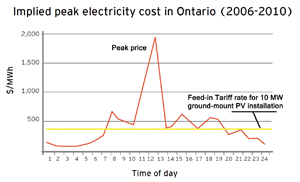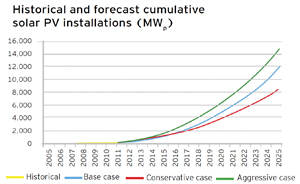“By 2025, solar energy is widely deployed throughout Canada, having already achieved market competitiveness that removes the need for government incentives, and is recognized as an established component of Canada’s energy mix. The solar industry will be supporting more than 35,000 jobs in the economy and displacing 15 to 31 million tonnes of greenhouse gas emissions per year, providing a safer, cleaner environment for generations to come.”



The above quote is from the Canadian Solar Industries Association (CanSIA)’s “Solar Vision 2025” (see “Getting to 2025,” opposite). It has become a commonplace that electrical power from the sun will become more widespread and provide more power, at a lower unit price, as time goes on. CanSIA observes that capital costs and project development costs are falling, with costs of PV projects forecast to drop by more than 50% by 2025. The cost of solar PV generation is expected to decline from the current range of $300 to $410 per megawatt-hour to a range of $146 to $200 MWh. Given a chance, in other words, grid parity is just a matter of time (CanSIA stresses that PV is already competitive with the cost of peak power – see top graph this page.) Grid parity (around 2025 for the average cost of power in CanSIA’s projection), or even the day it comes near, will then unleash solar power’s full potential for emissions-free, reliable energy and a more sustainable world.
How will this evolution come about?
Some of it will come from continuous developments in both efficiency at converting light into electricity, and efficiency at cell manufacture. (See “The evolution of PV technology,” page 28). Some of it will come from efficiencies of scale. Already in the late 1990’s the Sacramento Municipal Utility District (SMUD) instituted a rooftop solar program with exactly that stated objective, of boosting demand so as to generate economies of scale in manufacturing. Ontario’s FIT and microFIT programs, with their local content requirements, can be expected to do the same, and in fact may be doing so already, with the numbers of module builders setting or scaling up in the province.
Related stories in this feature:
What’s behind Ontario’s PV boom?
Enbridge, First Solar announce more projects
First Solar and the Sarnia solar farm
Ontario’s solar sector evolves to meet the challenge of large scale application
The evolution of PV technology
Competition in the PV industry evolving quickly
How much is solar actually costing us?
Extracting additional benefits from solar installations
